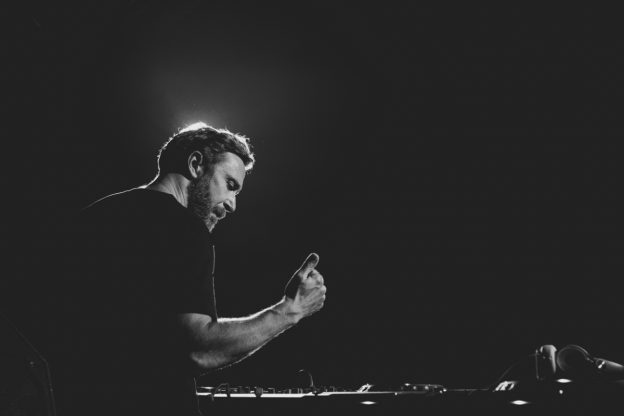David Guetta, the godfather of electronic dance music (EDM), started kicking out tracks in the late ’80s. Since then, he hasn’t stopped creating music, collaborating with new aspiring musicians and searching for the next best sound. During the Amsterdam Dance Event, we had the pleasure to talk with David about his favourite chord progressions, the new Future Rave tracks he’s working on and how to use Chordify as a DJ.
Hi David, how are you holding up during these strange times?
I’m doing well, thank you. Of course these are awful times for the music industry, but for me personally, it’s going okay. I’ve been on the road for 20 years, and I’m grateful to be one of the lucky ones that has a bit of money on the side, so I’m not stressing too much for now.
I’m using this time to focus more on creating every day, and be productive in the studio, which is normally not easy when I’m on the road. So, now I’m even deeper into music.
You know the drive is always to try to find a new sound.
We saw your fundraiser show in New York City. That was pretty awesome, but as Dutchies we found it even more interesting that you remixed the track “No Limits” from the ’90s Dutch house act 2Unlimited. Are the early days of electronic music still inspiring?
Ah yes, I do a lot of mashups. Because, with the rise of the possibilities that the internet has given us — like social media, YouTube and all those things — music has become very accessible. A DJ plays a record, you Shazam it, and there it is. What I try to do with my DJ-sets is to give people a unique experience. So I sometimes borrow from classics like “No Limits”, and combine it with my own work.
These are not simple mashups where you take an acapella and put it on top of another song. I actually reproduced the 2Unlimited riff, and combined it with a different song. This way the content that people experience when they come to see me is surprising and different than just mixing two songs together. If you call yourself an artist, you should be able to give your audience a unique live experience. I’m not talking about residence DJs of course.
When you’re working on new tracks and mashups, do you have a favourite key, or chord progression you like to fall back on?
Of course I have some favourite chord progressions when I make my own music, but when I’m creating a mashup, it’s different. There are a few ways of how you can do this. The most simple one is to take an acapella part that is for example in Am, and drop it on a tune that is in Am. What I do is a bit more complicated; I first analyse the key the acapella is written in, and after that I look for chords that I can play underneath the vocals. So I basically produce a tune to fit and stabilise the acapella part.
To make it sound really good I often reproduce the music part on my pads, or just replay the lead sound of a track with my own equipment to make it fit the sound of the mix better.
Very interesting. Thanks for elaborating a bit on the way you work. You are also a part of our Chordify community. Could you explain how an EDM producer uses a tool that analyses chords?
I’m happy to tell you! Before I do, we have to separate two different things. First of all, my work as a producer. When I’m creating a new song from scratch, I start out by looking for chords, a beat, a melody. Sometimes I work with a songwriter. Well, this part of my job does not include Chordify. [laughs]
The second part of my job is what I do as a DJ. I kind of already said it before, but when I’m making a mashup, I’m listening and looking for an acapella part that could fit over another record. To make it sound really, really good I don’t just combine the two together, but I often reproduce the music part on my pads, or just replay the lead sound of a track with my own equipment to make it fit the sound of the mix better. People don’t realise this, but when they hear a mashup they are like: “Wow! These songs fit perfectly and sound amazing together.” The reason for this is because I’m actually cheating a little bit. [laughs] Don’t tell anyone my secret, okay?
When I finish a record — literally one hour before a set — I put it on a USB stick and test it the very same night. This is the biggest rush I can get in my life.
So this is where Chordify comes in?
Exactly. When I’m working on a DJ set, it sometimes takes me two weeks to perfect it, but at the same time, it’s not a record that I’m putting out on the market. That’s why I want to be as time efficient as possible when it comes to finding out what I have to play and reproduce. So what I usually do is look at the different records that I want to play through Chordify, and compare the chords and the chord progressions.
There are a few ways in which I do this. Sometimes I receive a demo and I think that it’s cool but I’m looking for better chords. What I also do is go through songs I like on Chordify that have a similar tempo, change the key to the key of my song and imagine it on top. Sometimes I find inspiration like that, and replay new chords inspired by a reference on the top of a song that was written on a different chord progression. This can give a very unique feel, because the melody now feels more unexpected.
When I do all these things, I think in numbers, Roman numbers to be exact. A chord has its own Roman number in a scale, and if you have the chord progression in Roman numbers, you can transpose that chord progression to another key, but the overall feeling stays the same. That way I can recreate certain tracks by drawing the chords Chordify provides in my program, and adjust them to the key the acappella part that I want to use is in. The only thing is… You guys don’t provide the Roman numbers! Please add the Roman numbers and make my work easier. [laughs] Please!
We have some good news, we’re actually working on this. So this feature is coming soon.
[With a big smile] Thank God! It will not only help me by the way, it will help a lot of DJs who are doing the same thing that I am with their sets. Not everybody in the DJ world is musically schooled, so the power that comes with this technology is great. [Smiles] But enough about this, I’m sure you have other questions for me.
Yes we do! You’ve been called the grandfather of EDM, and…
[Interrupts by waving his hands while laughing] The GODFATHER! Not the grandfather. Man, I’m not that old.
Find out what your musical DNA is, and once you know, explore it, develop it.
Right! Our bad, you are the godfather indeed. That still makes you someone who’s been around for a very long time in this industry. Since you have a lot of resources, you enjoy a lot of fame, our question is: What is your drive to keep on going, to keep on producing?
Well, you know the drive is always to try to find a new sound. I’m very lucky that besides creating new music, I’m a DJ. So I can directly test my work on an audience. I actually do this very often. When I finish a record — literally one hour before a set — I put it on a USB stick and test it the very same night. This is the biggest rush I can get in my life. It’s what makes me very, very happy.
A lot of people know me for my pop songs, but at the moment I’m working with my good friend MORTEN on a new sound we call Future Rave, and this is really a new sound. To answer your question on how I stay motivated, the sensation you get from being able to make a cultural impact on my community is amazing. I’m creating the records that I want to play as a DJ.
When it comes to pop music, I try to do the same thing. It’s not only about chord progressions, it’s also about sounds. With the right chord progression you can write the right melody, but when you combine the right melody with the right sound… [sits back and smiles] Yes, that’s where the magic happens.

Awesome. Since you are on a very tight schedule we have one final question. Do you have any tips for beginning musicians?
This is difficult… [thinks for a while]. Well you know honestly, since we’re talking about making music, a big part of becoming a good musician is by copying artists you love. I think that when you try to copy the music or the sound of someone you start to understand why you love a specific tune, beat, or melody. It gives you insight and understanding of yourself.
[Smiles] And this is why Roman numbers are important. Once you find out that going — for example — from I to V you create that special sound you love, you can use it to your advantage. But even more important, it gives you an insight of your musical DNA.
I personally had this when I worked together with a very experienced musician. He came into my studio and said: “I have studied your DNA, I know you. I can play ten chords in the same key back to back which I know you love, and I can do the same with ten chord combinations you really hate.” When I answered in surprise he explained to me that I love certain patterns. He proved it to me by playing different combinations of chords and melodies which according to him were part of my DNA. He was right, I loved them, and it amazed me. So my tip is: find out what your musical DNA is, and once you know, explore it, develop it.
Great tip, thanks David! Enjoy your stay in Amsterdam, until the next time, and happy jamming!
Bye guys! And don’t forget about the Roman numbers.


